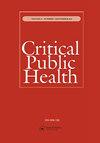What’s the problem represented to be? A critical analysis of problem representation in news media and public health communication during a hepatitis A outbreak in San Diego, California, USA
IF 2.3
3区 医学
Q2 PUBLIC, ENVIRONMENTAL & OCCUPATIONAL HEALTH
引用次数: 0
Abstract
ABSTRACTDiscourse regarding public health problems disproportionately affecting marginalized communities may shape and sustain health inequities. Analyses of news media and public health communications in the wake of infectious disease outbreaks provides opportunities to examine how discourse produces dominant public perceptions about the drivers of health emergencies and who is responsible for protecting community health. Guided by Bacchi’s “What is the Problem Represented to Be?” analytic approach, this paper critically examines the discursive construction of problems and solutions in news media (n = 35) and public health communication (n = 18 press releases, n = 1 governmental report) regarding an unprecedented hepatitis A outbreak in San Diego, California, USA (2016–2018) that disproportionately affected people experiencing homelessness. We organize our findings around three elements of problem and solution representation with respect to the outbreak: 1. The inequitable attribution of risk and deservingness; 2. assumptions divorced from socio-structural factors and perspectives of marginalized populations; and 3. political theatre as a means of blame-shifting and (in)action. Overall, our findings suggest that even when structural-level issues were acknowledged within news media and public health communication as undergirding the ‘problem’ of the hepatitis A outbreak, outbreak discourse focused on individual-level responsibility for both the causes of and solutions to it (e.g. vaccines, criminalization of homelessness), and on shifting blame between government actors. These findings have implications for understanding the role that news media and public health agencies play in shaping public perception of the causes, consequences and solutions to infectious disease outbreaks that disproportionately affect marginalized populations.KEYWORDS: Homelessnesshealth communicationhealth inequitiesdisease outbreaks Disclosure statementNo potential conflict of interest was reported by the author(s).Additional informationFundingThe author(s) reported there is no funding associated with the work featured in this article.这个问题代表了什么?在美国加利福尼亚州圣地亚哥甲型肝炎爆发期间,对新闻媒体和公共卫生传播问题代表性的批判性分析
关于公共卫生问题的论述不成比例地影响边缘化社区可能形成和维持卫生不平等。对传染病暴发后新闻媒体和公共卫生传播的分析提供了机会,可以研究话语如何产生公众对突发卫生事件驱动因素的主导看法,以及谁负责保护社区卫生。以巴奇的《问题代表的是什么?》本文采用分析方法,批判性地考察了新闻媒体(n = 35)和公共卫生传播(n = 18新闻稿,n = 1政府报告)中关于美国加利福尼亚州圣地亚哥(2016-2018)前所未有的甲型肝炎爆发的问题和解决方案的话语结构,该爆发对无家可归者的影响不成比例。我们围绕爆发方面的问题和解决方案的三个要素来组织我们的调查结果:风险和应得性的不公平归属;2. 脱离社会结构因素和边缘人口观点的假设;和3。作为推卸责任和行动手段的政治戏剧。总体而言,我们的研究结果表明,即使在新闻媒体和公共卫生传播中承认结构层面的问题是甲型肝炎爆发的“问题”的基础,爆发话语也侧重于个人层面对其原因和解决方案的责任(例如疫苗,将无家可归者定为刑事犯罪),以及政府行为者之间的责任转移。这些发现有助于理解新闻媒体和公共卫生机构在塑造公众对影响边缘化人群的传染病爆发的原因、后果和解决办法的看法方面所起的作用。关键词:无家可归者卫生传播卫生不平等疾病暴发披露声明作者未报告潜在的利益冲突。其他信息资金作者报告没有与本文所述工作相关的资金。
本文章由计算机程序翻译,如有差异,请以英文原文为准。
求助全文
约1分钟内获得全文
求助全文
来源期刊

Critical Public Health
Multiple-
CiteScore
5.90
自引率
7.10%
发文量
36
期刊介绍:
Critical Public Health (CPH) is a respected peer-review journal for researchers and practitioners working in public health, health promotion and related fields. It brings together international scholarship to provide critical analyses of theory and practice, reviews of literature and explorations of new ways of working. The journal publishes high quality work that is open and critical in perspective and which reports on current research and debates in the field. CPH encourages an interdisciplinary focus and features innovative analyses. It is committed to exploring and debating issues of equity and social justice; in particular, issues of sexism, racism and other forms of oppression.
 求助内容:
求助内容: 应助结果提醒方式:
应助结果提醒方式:


